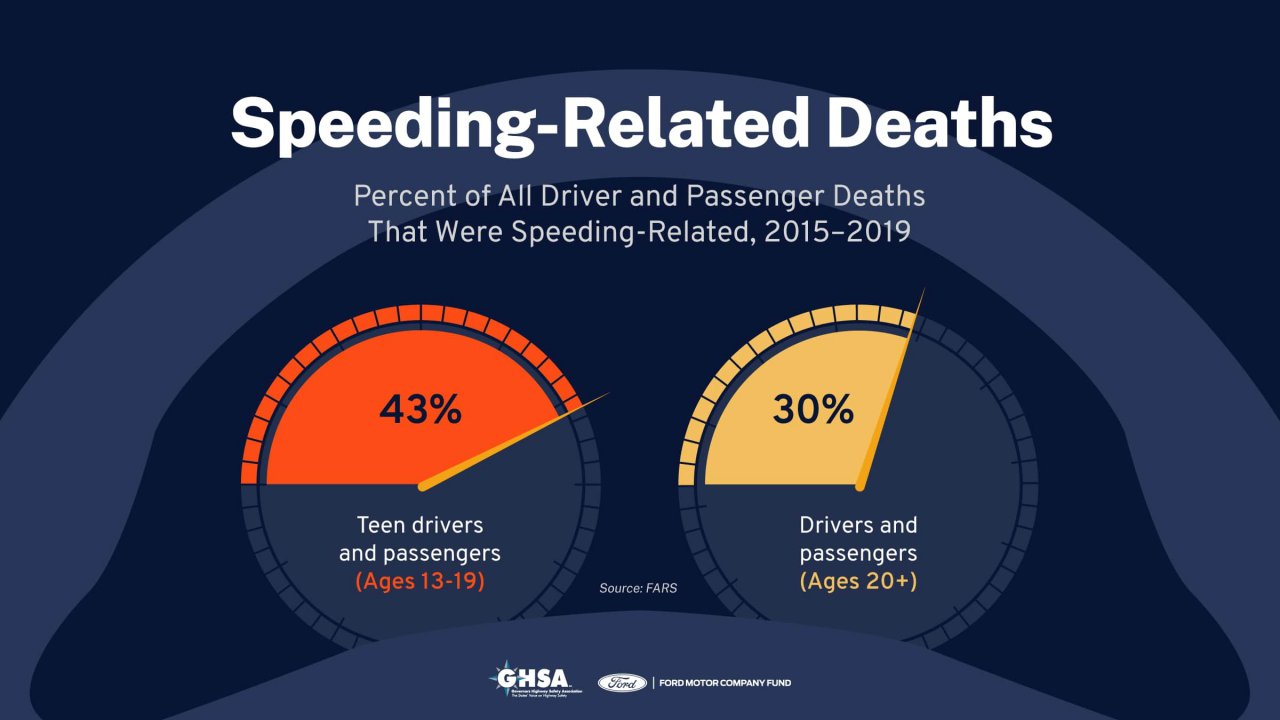Other than the collector car auction and car show calendars, there seems to be no rhyme nor reason to the flow of news releases into my inbox. But I was struck recently by the back-to-back arrival of two such items.
The first was from Ford and was titled “As Traffic Deaths Spike During COVID-19, New Report Examines Unsettling Trend of Teen Drivers Speeding — and Dying — on America’s Roads.”
The news release reported that Ford and the Governors Highway Safety Association have done a study of traffic fatalities from 2015 to 2019 and discovered that teen drivers were disproportionately involved in crashes resulting in speeding-related deaths.
While 30 percent of vehicle deaths of those 20 years of age or older are related to speeding, speeding underlies 43 percent of teenagers’ traffic deaths.
And it’s not only speeding teenage drivers who are dying or being hospitalized. It’s also their passengers.
I’m the grandfather of three teenage drivers, one of whom only recently received his learner’s permit. As a father, I also taught three teenagers how to drive. Yes, I care, and so should everyone who ever ventures out beyond the end of their own driveways or apartment parking lots.

Three bullet points to ponder:
* “The report, Teens and Speeding: Breaking the Deadly Cycle, is the first look in recent years at the role speeding plays in teen driver deaths and… sheds new light on what we know about speeding-related fatal crashes involving teens – the driver is more likely to be male, have run off the road or rolled the vehicle, and be unbuckled.”
- “While the report includes data through 2019, the new analysis of teen driving deaths is timely as overall traffic crashes have spiked during the COVID-19 pandemic and speeding on less-crowded than normal roadways is cited by states as a major factor in the surge in motor vehicle deaths. Parents may also have less time to spend training their teen drivers given other priorities during the pandemic.”
Excuse me! How can properly preparing your child for engaging in driving and his or her safety and that of others they encounter on the roads not be a priority?
- “The GHSA report also notes the risk of a teen driver being involved in a speeding-related fatal crash rises exponentially (my emphasis) with each additional passenger in the vehicle. This is a worrying situation as more teens eager to see their friends may drive around together as COVID-19 vaccines become more readily available.”
From what I’ve observed during this period of “distance learning,” teens are even more eager than before to jump into a car together to enjoy time with friends they aren’t seeing in person during the school day.
And speaking of schools, haven’t they all pretty much abandoned driver-training classes?
The news release quotes the governors safety group executive director Jonathan Adkins: “Our country has a speeding problem that has only worsened during the COVID-19 pandemic. Thousands of people die needlessly on our roads because some drivers mistakenly think less traffic means they can speed and nothing bad will happen. The data tell us that teen drivers are the most likely to be tempted to speed, so the need to address this issue is more critical than ever given traffic death trends during the pandemic.”

“Teens don’t see speeding as a serious problem and parents likely don’t recognize how rampant it is for novice drivers,” adds Ford’s Jim Graham, “so teaching them about the impact is critical.”
The governors’ safety group points out ways parents can “help rein in speeding teens, as well as re-evaluate their own driving behaviors.”
There are programs such as Ford’s Driving Skills for Life driving instruction classes, as well as other teenage driving-safety classes. But there is another that seems to me a no-brainer — the teenager’s smartphone, which is often seen as a detriment to safe driving and an object that detracts their attention from the road ahead.
There are apps, such as Life360, that enable parents not only to know where their teen may be at any given time, but how fast that teen is traveling whether the teen is driving the car or simply riding along.
As a followup to the study, the governors’ safety group and Ford plan an hour-long webinar on teens and speeding on February 4. As they say about some television programs, parental attention is advised.
Yes, automotive enthusiasts, this is a major issue that not only deserves but demands our attention. Not only do we love our cars and driving them, but even more so we love our teenage children and grandchildren and even our neighbors’ children and grandchildren and their neighbors and…

And this issue is so important that I’m going to save that other news release to share another time. In the meantime, I urge you to have a talk with your teen.






These stats illustrate the need for good driver education. By good, I mean a professional driver’s ed as offered by most local race track organizations. My daughter did one of these classes over 20 years ago with BSR at Summit Point and it saved her life. During the incident, she said everything she had learned during the on track class kicked in as a reflex. As a bonus, the opportunity to drive at the limits on a closed coarse often gets the crazy urges out of their systems (or hooks them on a fun hobby that can last a lifetime). Spend the couple hundred bucks and get them the training they need. Better still, take the class with them!
When I was 61, I joined a bunch of 16 year olds in one-day teenage driving course offered by the Bondurant school near Phoenix. It was a real eye-opener for the young drivers, especially the time spent on distracted driving. It also opened the eyes of some of the parents who stayed around to watch. Hands on the steering wheel, not the smartphone.
I may not have children of my own but as the uncle of a new driver, I have a stake in this as well. And you’re exactly right that the best solution here is education. Educate your teen-drivers the risks and dangers of excessive speed. And educate them that they’re not invincible; that they can and will get hurt, or worse. I remember when I was a teen-driver in the 90’s and thought I was the next Rusty Wallace or something! I wasn’t and it’s only be the grace of God that I’m still here to talk about it. The answer is not installing some piece of software in their car, or a phone app. The answer is in spending time with your kids and educating them.
Everyone driving or being exposed on the road as a passenger or who has a teenaged relative or neighbor has a stake in this.
Why no mention of the Manufactures themselves? Horsepower is a big selling point with the young,ergo young “men” seek the thrill and bragging rights of powerful cars (and trucks) So, therefore, the advertising needs to be reviewed de strssing the power factor and some type of “override’ mechanism built in, which would reduce the opportunity to exceed speed limits!
The car companys should be held at falt, All they do is bring out more and more street cars with insane horse power, they need to be taken to court and sued for there actions.
No Gary Green, “they” do not need to do any such thing.
todays typical answer blame the car maker for the drivers actions
Kids and cars. Couldn’t help but reflect on a well known teen novella author back in the 50s, Henry Gregor Felsen. He penned a string of books about teen driving and tragedy (Hot Rod, Road Rocket, Crash Club, among others) begun when he was contacted by the Des Moines (Iowa) Safety Council to produce some stories for teens about the dangers of speed and driving. The National Safety Council even recognized his efforts, but I’m not sure the books really helped to decrease teen deaths. The books were slightly ahead of my time on the streets, but by the mid 60s I was doing my part in being stupid and reckless, taking great pride in my own “need for speed”. Is it the car company’s fault? Not hardly. Automotive history shows us that the first time two cars showed up in any community during those earliest years of the industry, the race was on to see who was faster. Heck, even Henry knew speed sold cars and participated in some racing until he scared himself just enough to hand the speed chores to somebody else!
The numbers are really alarming with regards to teen driver fatalities. TW is right, professional driver education is becoming more important as parents are unable to educate their teens properly at home. Even so, however, the recommendation is at least 60 hours of practice before getting their license, the majority of which will be done with parents. You have a great point in your article: during coronavirus parents may be spending less time on driver’s ed… but in my experience, I’ve seen a lot of parents who are unemployed or only part-time who have more time than ever, and it’s actually the stress of the pandemic that’s made it difficult for them to focus on teaching their kids driving skills. I think it’s a pretty common thought that even regular tasks seem more overwhelming than ever. At least in Canada, there’s an online course for parents to help make driving lessons less stressful. I’ve taken the course and it’s a really good tool — I hope that products like these will help create safer teen drivers, because those 60+ practice hours are amazing opportunities to ingrain safe driving habits in young drivers.